SKODA FABIA 2009 2.G / 5J Manual PDF
Manufacturer: SKODA, Model Year: 2009, Model line: FABIA, Model: SKODA FABIA 2009 2.G / 5JPages: 259, PDF Size: 31.99 MB
Page 71 of 259
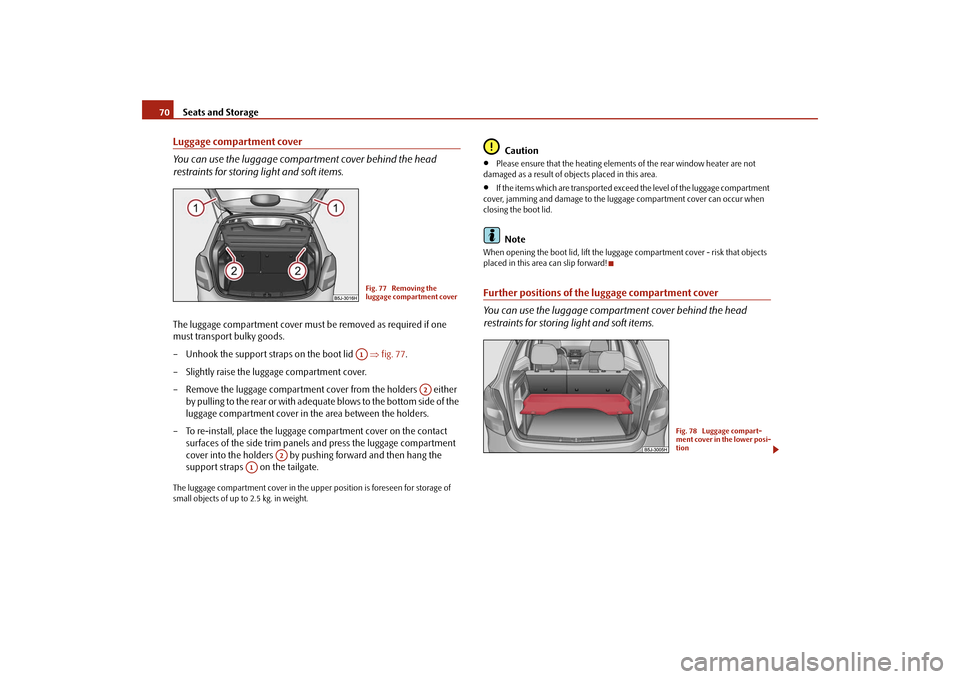
Seats and Storage 70Luggage compartment cover
You can use the luggage compartment cover behind the head
restraints for storing light and soft items.The luggage compartment cover must be removed as required if one
must transport bulky goods.
– Unhook the support straps on the boot lid ⇒fig. 77.
– Slightly raise the luggage compartment cover.
– Remove the luggage compartment cover from the holders either
by pulling to the rear or with a dequate blows to the bottom side of the
luggage compartment cover in the area between the holders.
– To re-install, place the luggage compartment cover on the contact
surfaces of the side trim panels and press the luggage compartment
cover into the holders by pushing forward and then hang the
support straps on the tailgate.The luggage compartment cover in the upper position is foreseen for storage of
small objects of up to 2.5 kg. in weight.
Caution
•
Please ensure that the heating elements of the rear window heater are not
damaged as a result of objects placed in this area.
•
If the items which are transported exceed the level of the luggage compartment
cover, jamming and damage to the luggage compartment cover can occur when
closing the boot lid.Note
When opening the boot lid, lift the luggage compartment cover - risk that objects
placed in this area can slip forward!Further positions of the luggage compartment cover
You can use the luggage compartment cover behind the head
restraints for storing light and soft items.
Fig. 77 Removing the
luggage compartment coverA1
A2
A2
A1
Fig. 78 Luggage compart-
ment cover in the lower posi-
tion
s3f4.1.book Page 70 Thursday, June 18, 2009 11:07 AM
Page 72 of 259
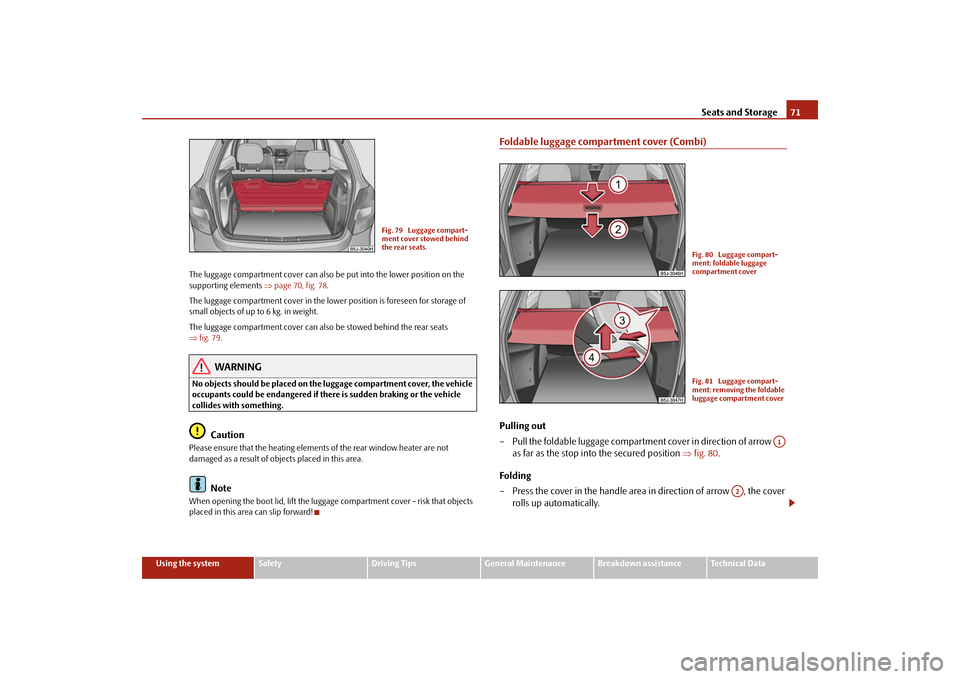
Seats and Storage71
Using the system
Safety
Driving Tips
General Maintenance
Breakdown assistance
Technical Data The luggage compartment cover can also be put into the lower position on the
supporting elements ⇒page 70, fig. 78.
The luggage compartment cover in the lower position is foreseen for storage of
small objects of up to 6 kg. in weight.
The luggage compartment cover can also be stowed behind the rear seats
⇒fig. 79.
WARNING
No objects should be placed on the luggage compartment cover, the vehicle
occupants could be endangered if there is sudden braking or the vehicle
collides with something.
Caution
Please ensure that the heating elements of the rear window heater are not
damaged as a result of objects placed in this area.
Note
When opening the boot lid, lift the luggage compartment cover - risk that objects
placed in this area can slip forward!
Foldable luggage compartment cover (Combi)Pulling out
– Pull the foldable luggage compartment cover in direction of arrow
as far as the stop into the secured position ⇒fig. 80.
Folding
– Press the cover in the handle area in direction of arrow , the cover
rolls up automatically.
Fig. 79 Luggage compart-
ment cover stowed behind
the rear seats.
Fig. 80 Luggage compart-
ment: foldable luggage
compartment coverFig. 81 Luggage compart-
ment: removing the foldable
luggage compartment cover
A1
A2
s3f4.1.book Page 71 Thursday, June 18, 2009 11:07 AM
Page 73 of 259
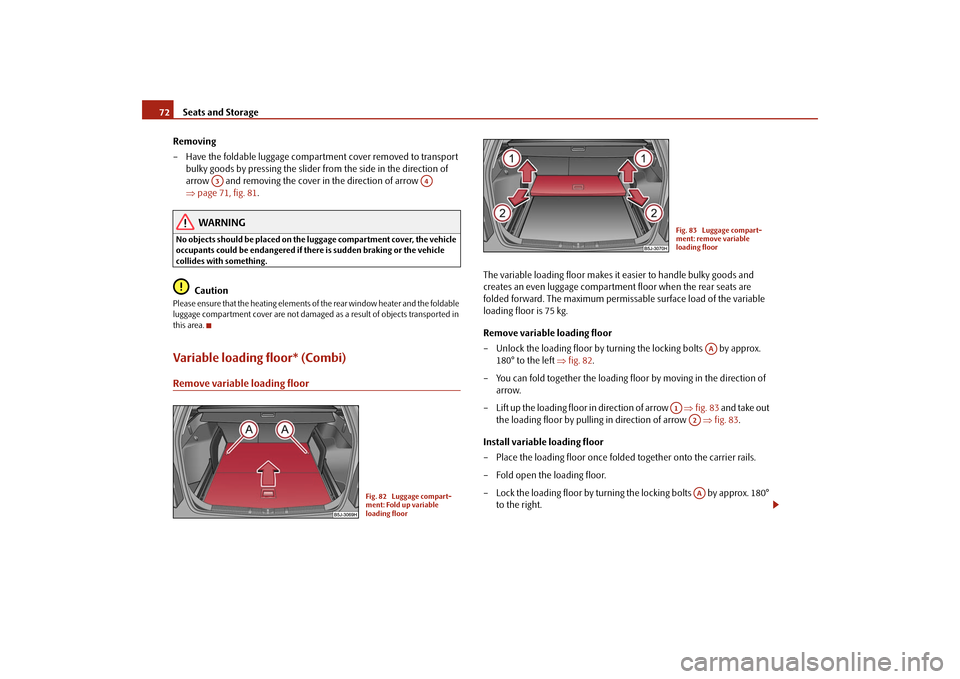
Seats and Storage 72
Removing
– Have the foldable luggage compartment cover removed to transport
bulky goods by pressing the slider from the side in the direction of
arrow and removing the cover in the direction of arrow
⇒page 71, fig. 81.
WARNING
No objects should be placed on the luggage compartment cover, the vehicle
occupants could be endangered if there is sudden braking or the vehicle
collides with something.
Caution
Please ensure that the heating elements of the rear window heater and the foldable
luggage compartment cover are not damaged as a result of objects transported in
this area.Variable loading floor* (Combi)Remove variable loading floor
The variable loading floor makes it easier to handle bulky goods and
creates an even luggage compartment floor when the rear seats are
folded forward. The maximum permissable surface load of the variable
loading floor is 75 kg.
Remove variable loading floor
– Unlock the loading floor by turning the locking bolts by approx.
180° to the left ⇒fig. 82.
– You can fold together the loading floor by moving in the direction of
arrow.
– Lift up the loading floor in direction of arrow ⇒fig. 83 and take out
the loading floor by pulling in direction of arrow ⇒fig. 83.
Install variable loading floor
– Place the loading floor once folded together onto the carrier rails.
– Fold open the loading floor.
– Lock the loading floor by turning the locking bolts by approx. 180°
to the right.
A3
A4
Fig. 82 Luggage compart-
ment: Fold up variable
loading floor
Fig. 83 Luggage compart-
ment: remove variable
loading floor
AA
A1
A2AA
s3f4.1.book Page 72 Thursday, June 18, 2009 11:07 AM
Page 74 of 259
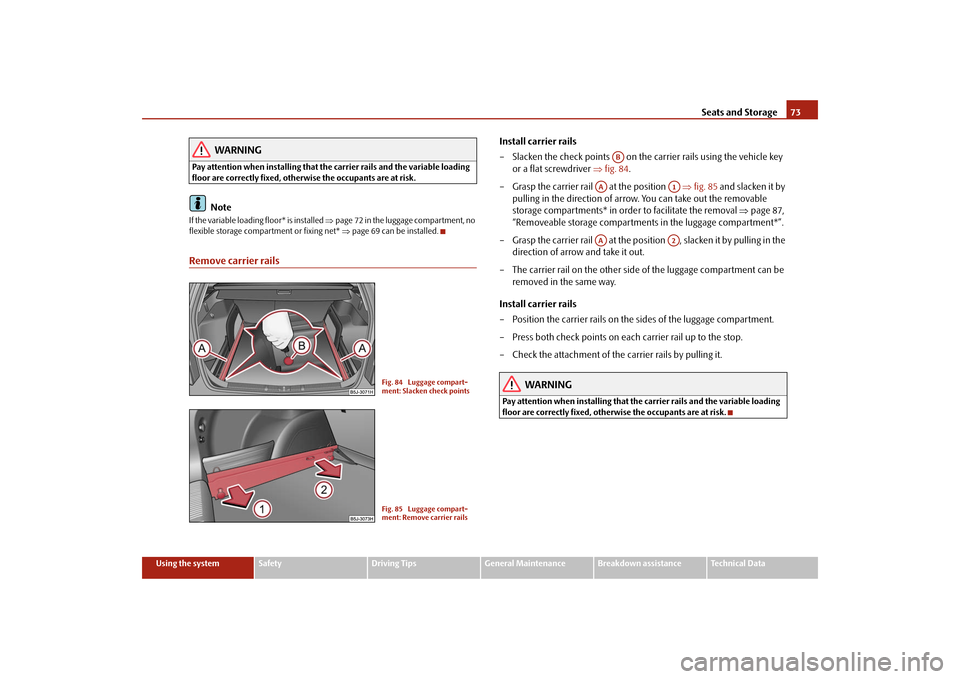
Seats and Storage73
Using the system
Safety
Driving Tips
General Maintenance
Breakdown assistance
Technical Data
WARNING
Pay attention when installing that the carrier rails and the variable loading
floor are correctly fixed, otherwise the occupants are at risk.
Note
If the variable loading floor* is installed ⇒page 72 in the luggage compartment, no
flexible storage compartment or fixing net* ⇒page 69 can be installed.Remove carrier rails
Install carrier rails
– Slacken the check points on the carrier rails using the vehicle key
or a flat screwdriver ⇒fig. 84.
– Grasp the carrier rail at the position ⇒fig. 85 and slacken it by
pulling in the direction of arrow. You can take out the removable
storage compartments* in order to facilitate the removal ⇒page 87,
“Removeable storage compartments in the luggage compartment*”.
– Grasp the carrier rail at the position , slacken it by pulling in the
direction of arrow and take it out.
– The carrier rail on the other side of the luggage compartment can be
removed in the same way.
Install carrier rails
– Position the carrier rails on the sides of the luggage compartment.
– Press both check points on each carrier rail up to the stop.
– Check the attachment of the carrier rails by pulling it.
WARNING
Pay attention when installing that the carrier rails and the variable loading
floor are correctly fixed, otherwise the occupants are at risk.
Fig. 84 Luggage compart-
ment: Slacken check pointsFig. 85 Luggage compart-
ment: Remove carrier rails
AB
AA
A1
AA
A2
s3f4.1.book Page 73 Thursday, June 18, 2009 11:07 AM
Page 75 of 259
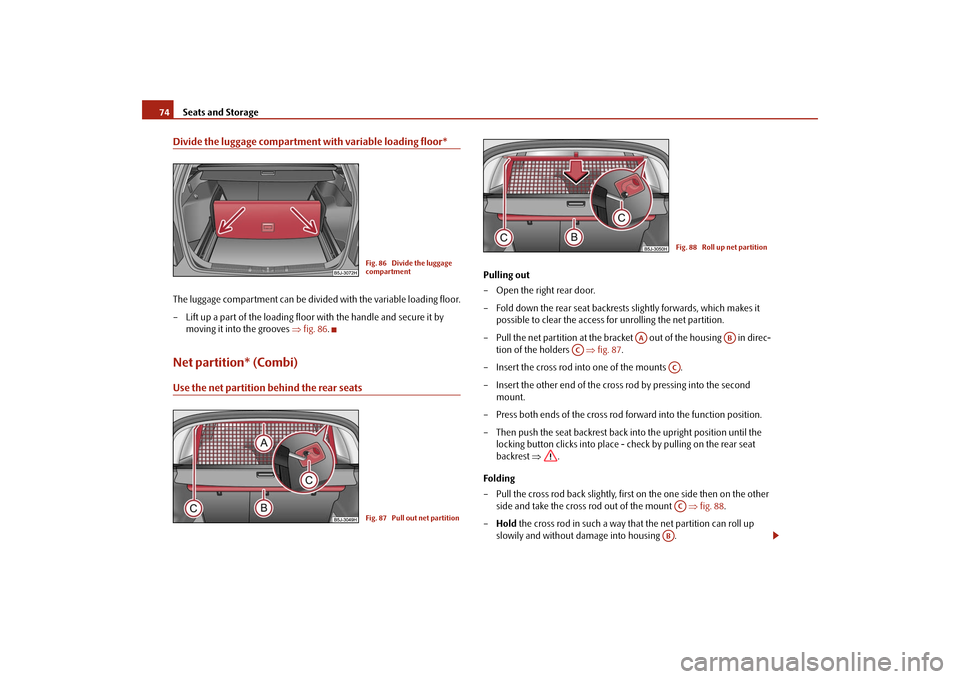
Seats and Storage 74Divide the luggage compartment with variable loading floor*The luggage compartment can be divided with the variable loading floor.
– Lift up a part of the loading floor with the handle and secure it by
moving it into the grooves ⇒fig. 86.Net partition* (Combi)Use the net partition behind the rear seats
Pulling out
– Open the right rear door.
– Fold down the rear seat backrests slightly forwards, which makes it
possible to clear the access for unrolling the net partition.
– Pull the net partition at the bracket out of the housing in direc-
tion of the holders ⇒fig. 87.
– Insert the cross rod into one of the mounts .
– Insert the other end of the cross rod by pressing into the second
mount.
– Press both ends of the cross rod forward into the function position.
– Then push the seat backrest back into the upright position until the
locking button clicks into place - check by pulling on the rear seat
backrest ⇒.
Folding
– Pull the cross rod back slightly, first on the one side then on the other
side and take the cross rod out of the mount ⇒fig. 88.
–Hold the cross rod in such a way that the net partition can roll up
slowily and without damage into housing .
Fig. 86 Divide the luggage
compartmentFig. 87 Pull out net partition
Fig. 88 Roll up net partition
AA
AB
AC
ACAC
AB
s3f4.1.book Page 74 Thursday, June 18, 2009 11:07 AM
Page 76 of 259
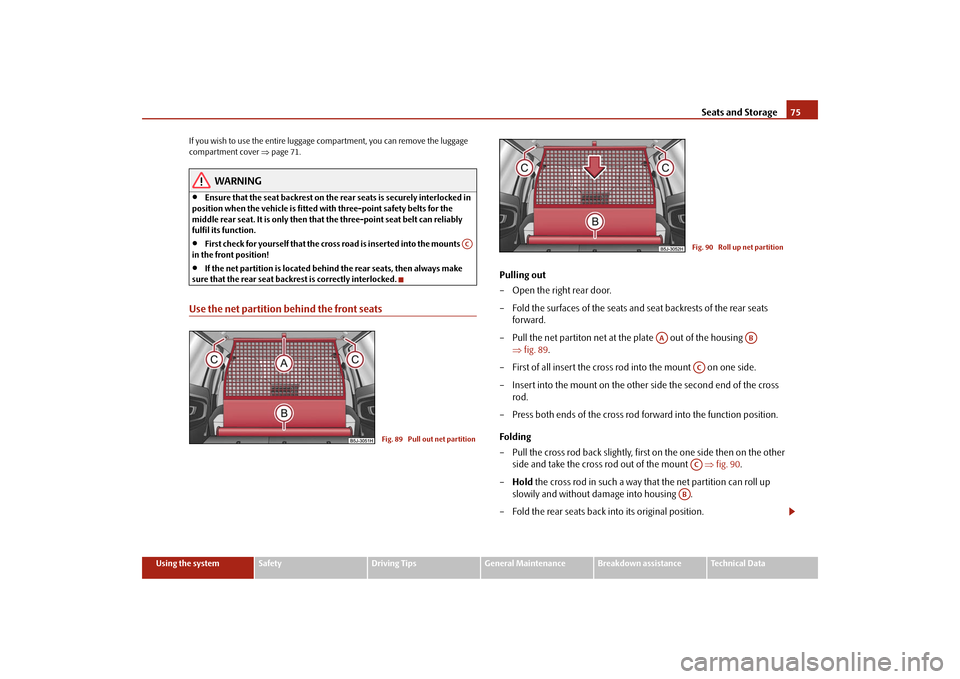
Seats and Storage75
Using the system
Safety
Driving Tips
General Maintenance
Breakdown assistance
Technical Data If you wish to use the entire luggage compartment, you can remove the luggage
compartment cover ⇒page 71.
WARNING
•
Ensure that the seat backrest on the rear seats is securely interlocked in
position when the vehicle is fitted with three-point safety belts for the
middle rear seat. It is only then that the three-point seat belt can reliably
fulfil its function.
•
First check for yourself that the cross road is inserted into the mounts
in the front position!
•
If the net partition is located behind the rear seats, then always make
sure that the rear seat backrest is correctly interlocked.
Use the net partition behind the front seats
Pulling out
– Open the right rear door.
– Fold the surfaces of the seats and seat backrests of the rear seats
forward.
– Pull the net partiton net at the plate out of the housing
⇒fig. 89.
– First of all insert the cross rod into the mount on one side.
– Insert into the mount on the other side the second end of the cross
rod.
– Press both ends of the cross rod forward into the function position.
Folding
– Pull the cross rod back slightly, first on the one side then on the other
side and take the cross rod out of the mount ⇒fig. 90.
–Hold the cross rod in such a way that the net partition can roll up
slowily and without damage into housing .
– Fold the rear seats back into its original position.
AC
Fig. 89 Pull out net partition
Fig. 90 Roll up net partition
AA
AB
ACAC
AB
s3f4.1.book Page 75 Thursday, June 18, 2009 11:07 AM
Page 77 of 259
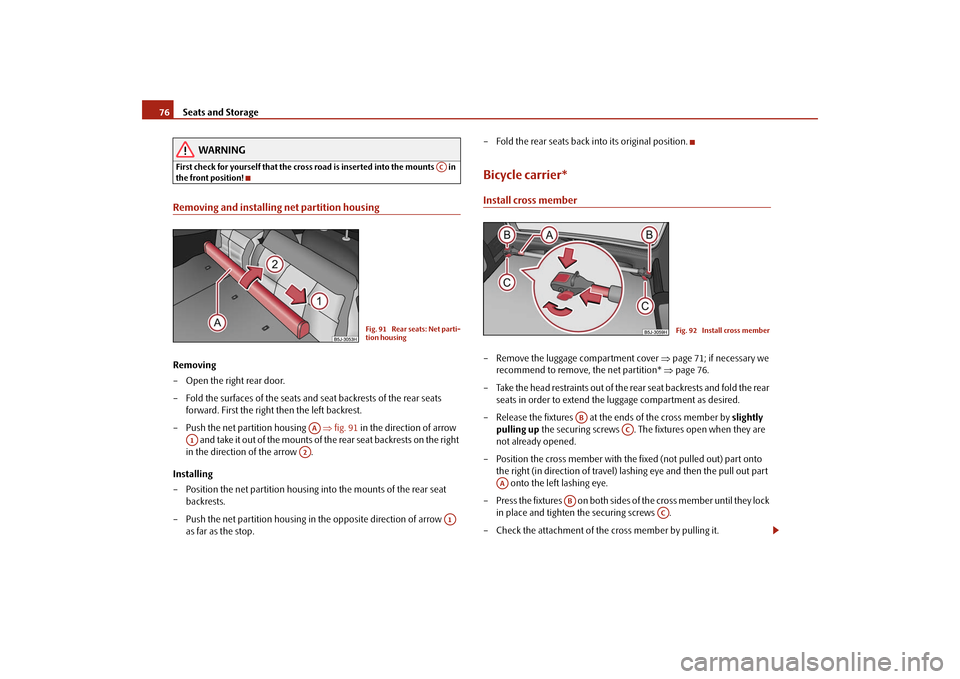
Seats and Storage 76
WARNING
First check for yourself that the cross road is inserted into the mounts in
the front position!Removing and installing net partition housingRemoving
– Open the right rear door.
– Fold the surfaces of the seats and seat backrests of the rear seats
forward. First the right then the left backrest.
– Push the net partition housing ⇒fig. 91 in the direction of arrow
and take it out of the mounts of the rear seat backrests on the right
in the direction of the arrow .
Installing
– Position the net partition housing into the mounts of the rear seat
backrests.
– Push the net partition housing in the opposite direction of arrow
as far as the stop.– Fold the rear seats back into its original position.
Bicycle carrier*Install cross member– Remove the luggage compartment cover ⇒page 71; if necessary we
recommend to remove, the net partition* ⇒page 76.
– Take the head restraints out of the rear seat backrests and fold the rear
seats in order to extend the luggage compartment as desired.
– Release the fixtures at the ends of the cross member by slightly
pulling up the securing screws . The fixtures open when they are
not already opened.
– Position the cross member with the fixed (not pulled out) part onto
the right (in direction of travel) lashing eye and then the pull out part
onto the left lashing eye.
– Press the fixtures on both sides of the cross member until they lock
in place and tighten the securing screws .
– Check the attachment of the cross member by pulling it.
AC
Fig. 91 Rear seats: Net parti-
tion housing
AA
A1
A2
A1
Fig. 92 Install cross member
AB
AC
AA
AB
AC
s3f4.1.book Page 76 Thursday, June 18, 2009 11:07 AM
Page 78 of 259
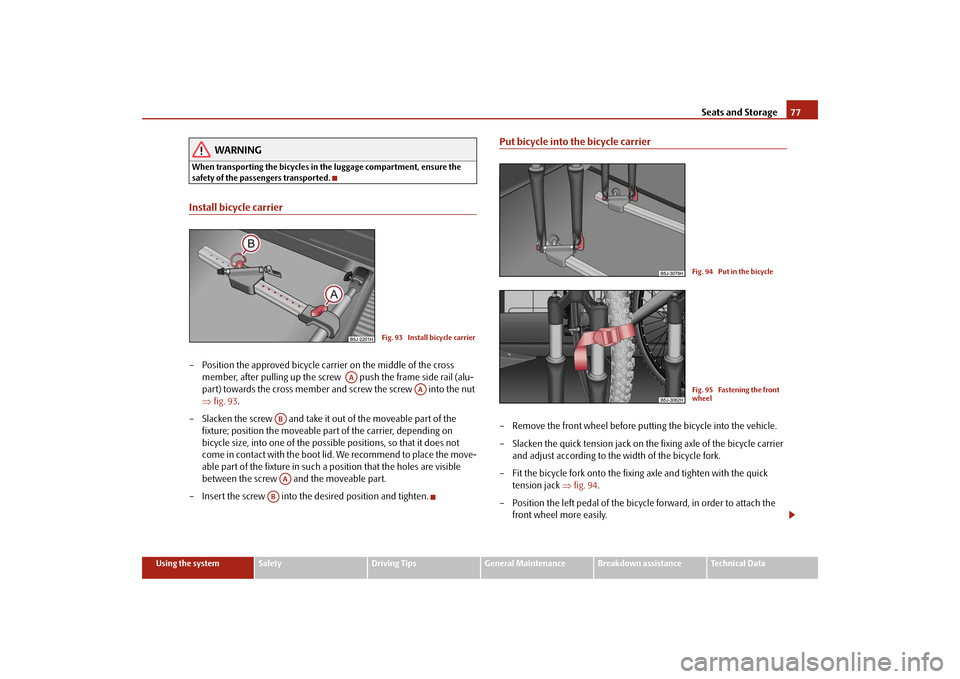
Seats and Storage77
Using the system
Safety
Driving Tips
General Maintenance
Breakdown assistance
Technical Data
WARNING
When transporting the bicycles in the luggage compartment, ensure the
safety of the passengers transported.Install bicycle carrier– Position the approved bicycle carrier on the middle of the cross
member, after pulling up the screw push the frame side rail (alu-
part) towards the cross member and screw the screw into the nut
⇒fig. 93.
– Slacken the screw and take it out of the moveable part of the
fixture; position the moveable part of the carrier, depending on
bicycle size, into one of the possible positions, so that it does not
come in contact with the boot lid. We recommend to place the move-
able part of the fixture in such a position that the holes are visible
between the screw and the moveable part.
– Insert the screw into the desired position and tighten.
Put bicycle into the bicycle carrier– Remove the front wheel before putting the bicycle into the vehicle.
– Slacken the quick tension jack on the fixing axle of the bicycle carrier
and adjust according to the width of the bicycle fork.
– Fit the bicycle fork onto the fixing axle and tighten with the quick
tension jack ⇒fig. 94.
– Position the left pedal of the bicycle forward, in order to attach the
front wheel more easily.
Fig. 93 Install bicycle carrier
AA
AA
ABAA
AB
Fig. 94 Put in the bicycleFig. 95 Fastening the front
wheel
s3f4.1.book Page 77 Thursday, June 18, 2009 11:07 AM
Page 79 of 259
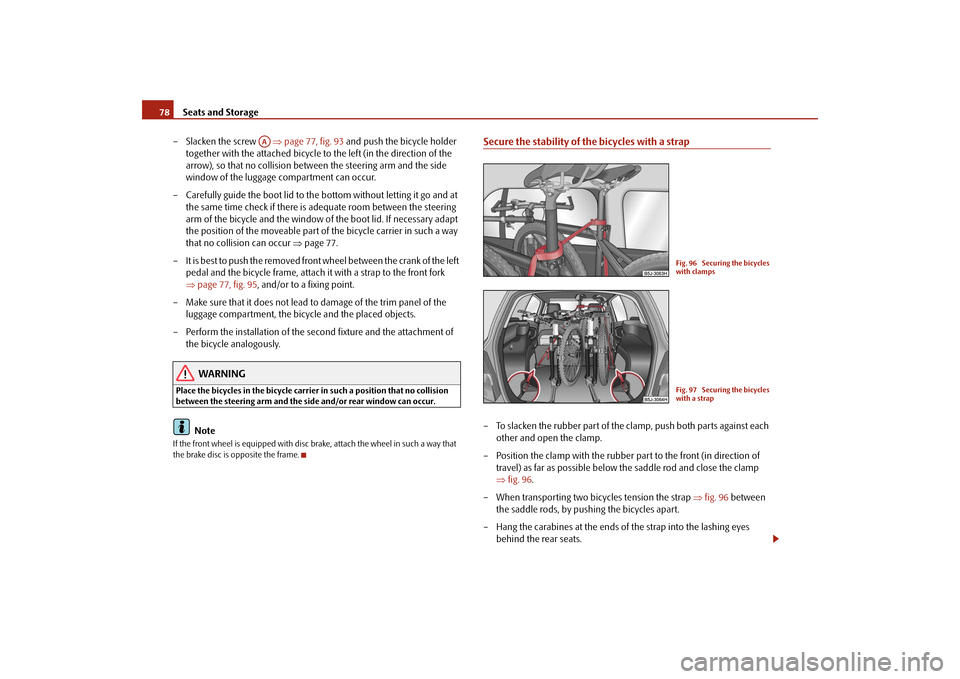
Seats and Storage 78
– Slacken the screw ⇒page 77, fig. 93 and push the bicycle holder
together with the attached bicycle to the left (in the direction of the
arrow), so that no collision between the steering arm and the side
window of the luggage compartment can occur.
– Carefully guide the boot lid to the bottom without letting it go and at
the same time check if there is adequate room between the steering
arm of the bicycle and the window of the boot lid. If necessary adapt
the position of the moveable part of the bicycle carrier in such a way
that no collision can occur ⇒page 77.
– It is best to push the removed front wheel between the crank of the left
pedal and the bicycle frame, attach it with a strap to the front fork
⇒page 77, fig. 95, and/or to a fixing point.
– Make sure that it does not lead to damage of the trim panel of the
luggage compartment, the bicycle and the placed objects.
– Perform the installation of the second fixture and the attachment of
the bicycle analogously.
WARNING
Place the bicycles in the bicycle carrier in such a position that no collision
between the steering arm and the side and/or rear window can occur.
Note
If the front wheel is equipped with disc brake, attach the wheel in such a way that
the brake disc is opposite the frame.
Secure the stability of the bicycles with a strap– To slacken the rubber part of the clamp, push both parts against each
other and open the clamp.
– Position the clamp with the rubber part to the front (in direction of
travel) as far as possible below the saddle rod and close the clamp
⇒fig. 96.
– When transporting two bicycles tension the strap ⇒fig. 96 between
the saddle rods, by pushing the bicycles apart.
– Hang the carabines at the ends of the strap into the lashing eyes
behind the rear seats.
AA
Fig. 96 Securing the bicycles
with clampsFig. 97 Securing the bicycles
with a strap
s3f4.1.book Page 78 Thursday, June 18, 2009 11:07 AM
Page 80 of 259
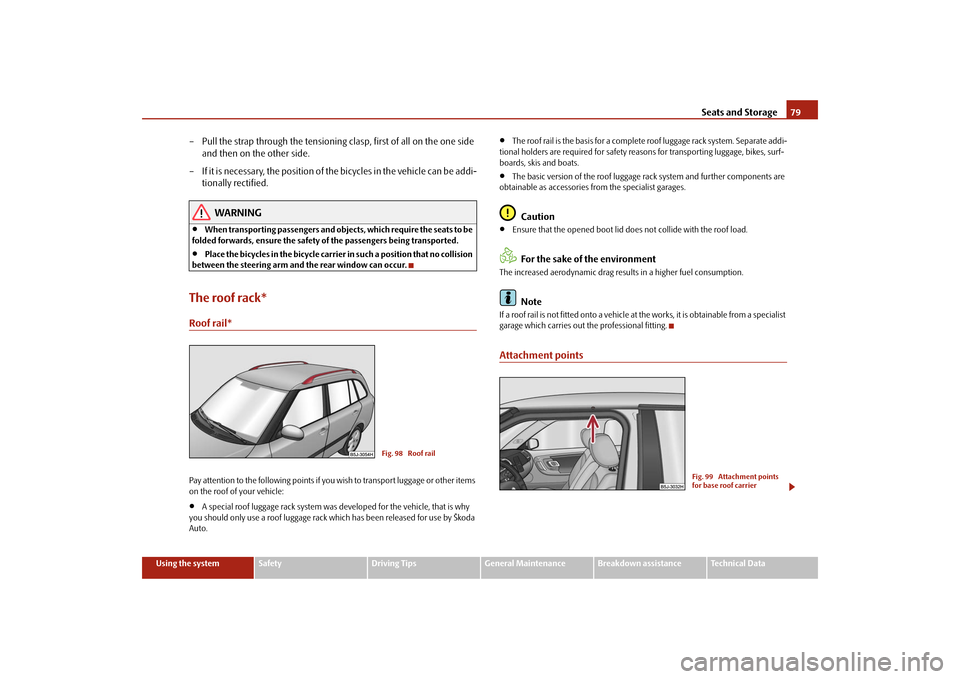
Seats and Storage79
Using the system
Safety
Driving Tips
General Maintenance
Breakdown assistance
Technical Data
– Pull the strap through the tensioning clasp, first of all on the one side
and then on the other side.
– If it is necessary, the position of the bicycles in the vehicle can be addi-
tionally rectified.
WARNING
•
When transporting passengers and objects, which require the seats to be
folded forwards, ensure the safety of the passengers being transported.
•
Place the bicycles in the bicycle carrier in such a position that no collision
between the steering arm and the rear window can occur.
The roof rack*Roof rail*Pay attention to the following points if you wish to transport luggage or other items
on the roof of your vehicle:•
A special roof luggage rack system was developed for the vehicle, that is why
you should only use a roof luggage rack which has been released for use by Škoda
Auto.
•
The roof rail is the basis for a complete roof luggage rack system. Separate addi-
tional holders are required for safety reasons for transporting luggage, bikes, surf-
boards, skis and boats.
•
The basic version of the roof luggage rack system and further components are
obtainable as accessories from the specialist garages.Caution
•
Ensure that the opened boot lid does not collide with the roof load.For the sake of the environment
The increased aerodynamic drag results in a higher fuel consumption.
Note
If a roof rail is not fitted onto a vehicle at the works, it is obtainable from a specialist
garage which carries out the professional fitting.Attachment points
Fig. 98 Roof rail
Fig. 99 Attachment points
for base roof carrier
s3f4.1.book Page 79 Thursday, June 18, 2009 11:07 AM